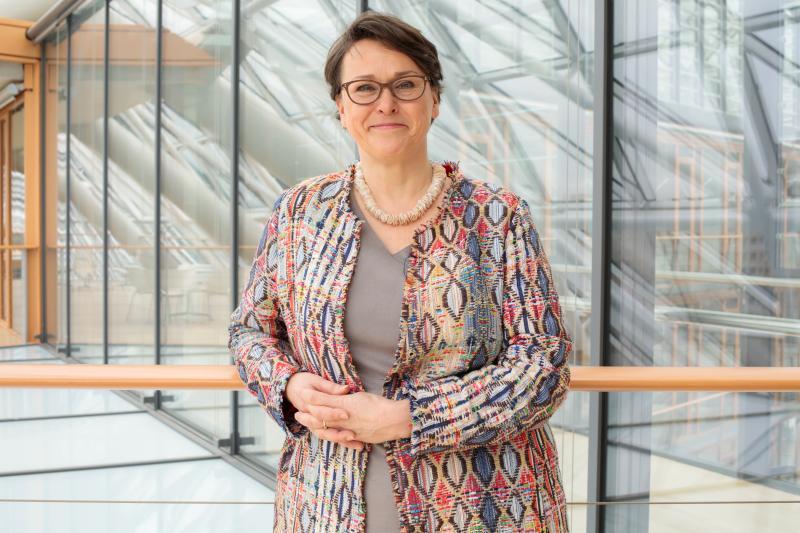That is good for women. More than that, it is good for the EIB and ultimately good for the EU citizens who are served by our work. Gender equality has a strong, positive impact on growth in terms of GDP, employment, productivity and competitiveness. It promotes social inclusion and contributes to improved living conditions for this generation and the next, and it ensures that institutions are more representative, mirroring the population for which they work. In the EU alone, greater efforts toward gender equality would lead to an increase in GDP per capita between 6 and 9% by 2050. Conversely, according to a Eurofound survey, the total cost of lower female employment runs into billions every year. In 2013 alone it was EUR 370 billion. That is close to 3% of EU GDP.
So this is a macro problem for Europe. It is also a personal quest for me. As a nineteen-year-old, I went to study in Germany. It was there that I first noted the differences in the way women are treated in the workplace, when I took a job at Dresdner Bank in Leipzig. The Communist regime in East Germany had of course been responsible for many outrages. But it had also instilled a belief in equality between men and women that persisted after its welcome demise. This was an inspiring time in my career, where I worked on training programmes for young women whose contribution was truly valued. I also came into contact with the machismo of many men in the banking sector. I noticed that the equality of eastern German women was not mirrored in what had been West Germany and I saw that often reflected in the attitudes of men from that part of the country. In my interactions with them, I started to develop a theory that I am only now crystallising. I would call it the “force of nature Finnish woman” theory.
Because I was not treated differently from my brothers, I grew up with a sense that I could do whatever I wanted. I was not limited by my gender and I did not have to temper my behaviour to make myself acceptable somehow to men. Over the years I have noticed that some women from some other cultures do indeed modify their behaviour so that they will be perceived by men as less threatening or dominant. This can mean speaking more quietly than they otherwise would or deferring to men who interrupt them at meetings. This does not happen to me—or to other Finnish women at the EIB who have also remarked on this phenomenon, such as Eila Kreivi, our capital markets director and a woman of very strong, direct demeanour.
Here our Finnish background helps us doubly, perhaps. Because there are simply not many Finns—male or female—in major EU organisations, a few assertive women can be seen as characterful and direct. If we were more numerous, it is possible that we would have faced a backlash. Even as it is, Eila was once told by her boss that she should not apply for a particular job because there would then be only women in that part of the bank. Eila responded that there were only men in the area where she had been working and it seemed that was not a problem. Her boss relented.
It is certainly true that there has been considerable progress in gender equality at EU institutions in the two decades during which I have worked at the European Commission, the European Investment Fund (the EIB’s subsidiary specialising in small and medium-sized business support) and the EIB. This reflected broad changes in society and business, and of course it is still not enough.
I joined the Commission immediately after Finland’s 1995 accession to the EU. We joined alongside Sweden and Austria, and these three countries changed the EU considerably, given that none was a large nation. First, we pushed for a shift from French to English as the language of daily operations in the EU institutions. Second, many of us noticed that the working arrangements at the Commission were old-fashioned and orientated toward a male workforce. Teleworking, maternity leave and part-time arrangements were limited. I helped to build a Women’s Network at the Commission. At our first meeting, we hung a sign on the door that said “Female Entry Only.” We had a fight on our hands, but in the end we were able to make significant changes that favoured women. For example, a rule was instituted that meetings could not be held before 9.30 in the morning and could not be started after 5.30 p.m. This was important for women, on whom the burden of rushing from work to pick up children from day-care typically fell. It also represented an important improvement in the family lives of fathers, too. We expanded our network to join with women in other EU bodies, such as Eurostat and the Publications Office.
Notably this did not extend to the EIB. It was not until 2014 that a small group of women at the bank set up an informal network called ConnectedWomen. It was founded by an Italian and an Irish woman, but it was to a pair of Finnish women that they turned for support on a more senior level. First Eila Kreivi attended one of their meetings to give a mentoring talk about careers at the EIB. Then I became the group’s sponsor, because I was deputy chief executive of the EIF at the time and was able to give them the backing of my seniority and influence. They certainly needed this. The group was challenged within the bank by certain people who argued that a body could not be formed that excluded anyone on the basis of a choice by the members of that body—as if women had chosen to be women. Nonetheless, an investigation took place to determine whether the bank’s code of conduct had been violated. To the bank’s credit, ConnectedWomen was cleared, though it has no official sponsorship. It now has 600 women as members within the bank, organizing regular mentoring and discussion sessions. Interestingly, ConnectedWomen has been supported by the bank’s current and previous Vice Presidents from Finland, who have been responsible for the diversity and inclusion portfolios. This was extremely useful to me as I worked to drive forward a diversity and inclusion strategy. Over the next four years, we must deliver on the pledges in that strategy, measure our progress and, in 2021, carry out a full evaluation.
The need for a true diversity policy was evident at the bank, when I joined in 2015. At the same time as we were instituting a gender lending policy, which maintained that companies and institutions who take loans from the EIB must ensure that their investments and projects protect the rights of women and have a positive impact on women’s lives, within the EIB we could not be said to be making progress in gender equality. The organisation was bottom-heavy with women. The lowest grades of staff were—and continue to be—overwhelmingly female. At senior level, only 18 out of 54 staff are women, a portion that has changed little in recent years. Of the bank’s 12 directorates, only one was headed by a woman until I took on my new post in March. The diversity strategy sets 33% as the target for the number of senior cadre who will be women by 2021. The president of the EIB, Werner Hoyer, stands firmly behind gender equality in the bank’s business and within the bank.
In my new role, I hope to bring the forthrightness of a Finn and the strength of a woman to bear on this diversity challenge—as well as the other considerable tests that the bank and the EU itself must overcome in this age of populist politics and general turmoil. As the IMF study showed, women contribute great stability to the management of banks. Certainly, stability is something that is needed in Europe and the world these days. The best way to achieve this at the EIB and elsewhere is by making our appraisals of our workers more frequent and more frank. We should be clear about what we expect from those who work for EU institutions, so that men and women can make their fullest contributions, feeling valued for the talents they display and gaining satisfaction from the knowledge that they are building a future in which their daughters will have the same opportunities as their sons. As Secretary-General of the EIB, I shall make it a priority to ensure that our staff get the training they need to develop their careers, regardless of their sex. That might just include learning how to change the tyres on a car.

